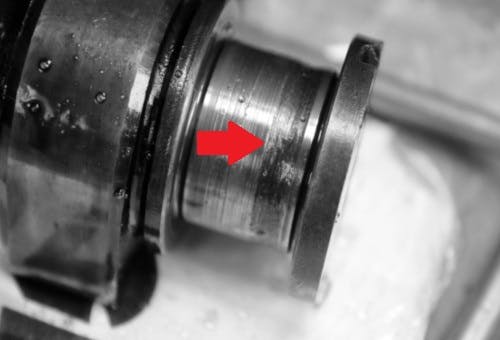How and Why do Camshafts Fail?
The short answer to the above questions is that although camshafts can, and very often do, suffer various kinds of damage, the fact is that camshafts very rarely, if ever, fail because of causes that involve camshafts themselves.
The damage to the camshaft shown in the above image is a good case in point. In this instance, the severe mechanical wear on the lobes resulted from a lack of proper lubrication, which is critically important for the correct and reliable operation of all valve train components.
As a practical matter, it hardly matters what caused the lack of lubrication in this example: the point is that this camshaft suffered severe damage by causes that did not involve the camshaft itself, i.e., the failure resulted from a failure of the engine’s lubrication system. As a matter of fact, it would not be an exaggeration to say that poor lubrication (of camshafts) is one of the two most common causes of various types of camshaft failures, with the other most common cause being aluminium cylinder heads that have deformed excessively as the result of severe or prolonged engine overheating. Consider the image below-

This image shows a cast aluminium cylinder head with a single overhead camshaft, but in the context of this discussion, the make and model of the engine it fits on is irrelevant because all cast aluminium cylinder heads deform in much the same way when an engine overheats severely or repeatedly. Let us look at what the lines and arrows mean, but note that on correctly installed cylinder heads that have never overheated, the bottom surface of the cylinder head and the centre line of the camshafts (s) will always be parallel over the length of the cylinder head-
- The green line at the bottom of the frame represents the flat surface that mates with the engine block when the cylinder head is bolted down
- The green line at the top of the frame represents the centre line of the camshaft when it is installed and secured by several bearing caps
- The large red arrow at the bottom of the frame represents the point where an aluminium cylinder head typically “bends” when it expands past its design limits during severe engine overheating
- The two smaller red arrows at the top of the frame represent the points where the structure of a cylinder head typically offers the most resistance to excessive deformation during severe or prolonged engine overheating
- The two curved red lines represent the typical deformation pattern that occurs when an aluminium cylinder head expands past its design limits. Note that, although the degree of deformation shown here by the two curved red lines is greatly exaggerated for clarity, much, if not all of the deformation that occurs at the cylinder head’s bottom surface is transferred to the surfaces that support the camshaft, with the highest degree of deformation occurring at about the mid-point of the camshaft’s length
So what’s the problem?
The problem is this: when a cylinder head undergoes typical repairs after an episode of engine overheating, only the bottom surface of the head is machined flat again to ensure proper fitment on the engine block. As a practical matter, this means that the "bore(s)" in which the camshaft(s) rotate are still deformed or curved, which forces the camshaft(s) to bend continually at about their midpoints as they rotate, which they were not designed to do without suffering at least one type of damage.
Therefore, in cases where a severe deformation of the camshaft(s) running surfaces is present, camshaft(s) can, and sometimes do, break into two or more pieces along their length at the point(s) where the degree of deformation is largest.
However, it is more common for camshafts that run in deformed bores to suffer localized lubrication failures, such as in the example shown below-

In this example of a localised lubrication failure resulting from excessive deformation of the cylinder head, the excessive heat caused by metal-to-metal contact between the camshaft journal and the cylinder head caused the aluminium in the contact area to melt. In cases like this, the molten aluminium mixes with near-molten surface metal from the camshaft, and the resulting hard abrasive material then grinds deep furrows (like the one shown) here into the affected camshaft journal and its running surface(s) in the cylinder head, which usually causes severe damage to the cylinder head, as well.
Although excessive deformation of cylinder heads does not always cause camshafts to fracture or break, localised lubrication failures such as in the example shown above account for a large percentage of all camshaft failures on engines with a) overhead camshafts, and b), engines with cast aluminium cylinder heads. Moreover, while it is often technically possible to re-align a camshaft's bore with the bottom surface of a cylinder head, the process is hugely time-consuming and, therefore, expensive because the repair process usually includes the fabrication of purpose-made bushings and/or bearing inserts to preserve the specified valve clearances. As a result, repairs of this nature usually cost about as much, or sometimes, significantly more than replacing most cylinder heads and camshafts.
Overall, it is perhaps worth repeating that camshafts fail for very few reasons, and when they do fail, the root cause(s) of the failure very rarely, if ever, involve inherent faults and/or defects in the vast majority of camshafts. Of course, there are always exceptions to every rule, but in the case of camshaft failures, the exceptions are so rare that they are essentially unheard of.
